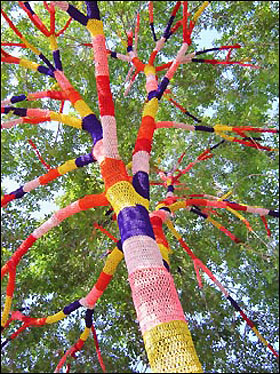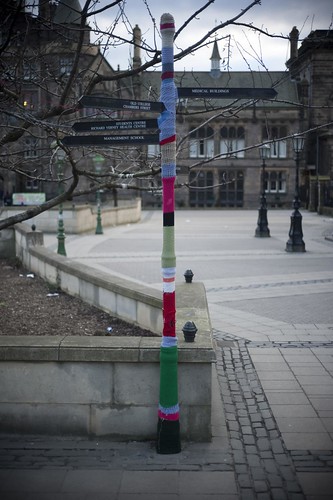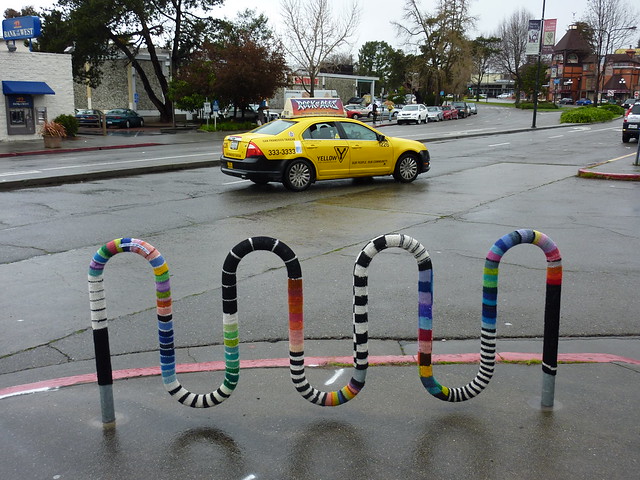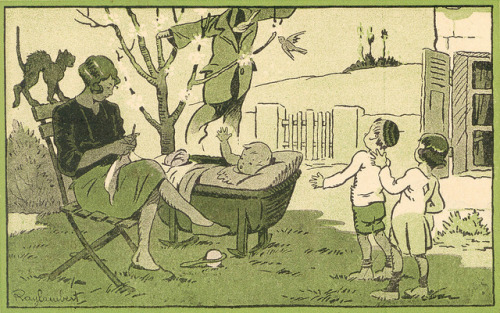Hi Everyone!
After a long hiatus I am happy to announce a very promising move to a new blog and new blogging platform- I will heretofore be writing from interrobangknits.wordpress.com!
This website gives me the chance to blog under a new name, with a much more professional platform, and gives me more control over how my writing gets out into the world.
For bloggers who are interested in why I'm making the switch from blogger to wordpress, there are some very important reasons that I hope you consider when creating new blogs.
Blogger is an excellent introductory platform, and for those uncomfortable with blogging, computers, and the internet, it is an easy way to start. However, the flip side of its simplicity is a lack of control for the blogger. At wordpress, I feel like I have much more ability to customize, build, and explore the inner workings of my blog. A few of my favorite wordpress features that blogger lacks are scheduling publication date and time to happen automatically, at the time of your choosing, checking statistics in both blog views and syndicated views (views in rss feeds), and a clean interface with extensive control options. To be honest, I haven't yet discovered all of the great features wordpress has, which is more than I can say about blogger, whose controls are limited mostly to design, and can be explored in a few hours.
Blogger's one perk, for those to whom this is important, is that it is easily monetized- if you're looking to make money from your blog, blogger is the place to do it. In fact, when you create a blog on this interface, one of the creation steps is choosing whether to monetize your blog at that time. Of course, I am sure that those who are looking to monetize wordpress would be able to do so, but I haven't worked on that feature. I am less interested in making money off of my blog and more interested in reaching an audience with information I find interesting and feel passionate about, and all of my needs were met more efficiently at wordpress.
I have to add how disappointed I am that I am writing this post. There is nothing wrong with blogger. In fact, I love love love google, gmail, and all of its constituents- it just turns out that wordpress is a better fit for my blogging preferences. Sorry google :(
I look forward to seeing everyone over at interrobang, and encourage all of my current readers and subscribers to move on over and read and subscribe at wordpress. It should be an awesome blog, with a much wider range of subjects and topics- but I do intend to continue publishing knitting history material, and I also plan to republish and revisit a few of the posts I published here, on the university knitter, in hopes of giving them a second chance to be read.
Have a great day, everyone! :)
Wednesday, June 22, 2011
Thursday, April 7, 2011
Knitted Graffiti (Part 2)
Knitted Graffiti, or 'Yarn Bombing,' has a plethora of meanings for the different people who participate in it. The practice can be traced back to Magda Sayeg, who, with her controversial knitting graffiti team 'Knitta, Please' worked to establish the art of knitted graffiti. Sayeg states that she started installing knitted graffiti "in response to the dehumanizing qualities of an urban environment. By inserting handmade art in a landscape of concrete and steel, she adds a human quality that otherwise rarely exists."
| Knitta, Please was responsible for 'Yarn Bombing' this bus in Mexico City. |
That comforting nature of knitting- both in its creation and in the final fabric- are utilized by Magda Sayeg and the yarn bombers who have followed her as a way to change the environment of many urban areas.
Knitted graffiti artists have popped up all over the world, and have influenced both the craft of knitting and the art of graffiti. I am particularly amused by Banksy's depiction of knitting in his own street art:
I think at the heart of the matter, though, knitters enjoy the process of making their craft. And after making sweaters and hats and scarves and mittens for all of their friends and family, there is some desire to bring joy to more people than they can reach directly. Placing knitted graffiti in public places for hundreds of people to enjoy is a way to use craft to reach out and brighten the day of someone you might never meet. After all, isn't it impossible not to smile when you find a streetlight wearing a sweater on your way to work?
Wednesday, April 6, 2011
Knitted Graffiti
The surge in popularity of knitted graffiti is one which has left me intrigued and dumbfounded. When I first saw a picture of knitted graffiti, I was surprised by how much time and energy someone had put into knitting an item which would eventually be dirtied, torn down and thrown away. Yet after reading article after article, and seeing more and more pictures representing the art that has been placed on display in streets around the world, the appeal of knitted graffiti begins to make more sense.
It all goes back to the concept of knitting as utilitarian. What once was necessary tool in daily life has become a craft that is done mainly for enjoyment. What was once a way to bring extra money into the household in times of desperation is rarely used as a means of necessary monetary gain today.
This is not the first time, however, that knitters are abandoning the useful nature of their craft. In the Victorian era, it became incredibly popular among those in the upper classes to knit things in miniature. It went along with their predisposition to hold their needles in a less comfortable way- these women went out of their way to make a distinction between those who had to knit to survive and those who chose to knit for pleasure.
The motivation behind knitting abstract and useless objects today is clearly not the same as it was for Victorian ladies. So, then; what is the motivation? Some large-scale PR stunt for a craft long considered one for the elderly? Another product of the community formed within knitting groups both in person and on the internet? A fun and harmless way for knitters to 'walk on the wild side?' Tune in tomorrow when I will do my best to answer the question of WHY people participate in knitted graffiti.
Tuesday, March 22, 2011
Taking Knitting to Extremes
Knitting has always been a very utilitarian skill- using a few double-pointed needles, women and children could make stockings to keep their family warm and dry, and maybe even bring in a few extra bucks.
The closer to the 21st century we get, the more room for exploration is possible for knitting, and playing with size to make creative and inspiring art has become more and more common.
Today I came across this video:
Laura Birek, author of the book Picture Perfect Knits, had the innovative idea of knitting with unspun roving and PVC pipes, to make a gigantic, cushy knitted blanket. I had already seen Bisuit Scout's knitted chairs defy expected proportions, but Laura Birek's oversized gauge produces a blanket of average size- it is the creation of the fabric, and the oversized stitches, that lend it a thickness and visual impact far greater than the average afghan.
Birek's polar opposite can be found in Althea Chrome, an Indiana based artist who spends her days knitting tiny miniature garments to scale (bug sized- hence the name of her company, Bugknits).
Chrome knits on tiny pins with the thinnest thread, and her creations sell for thousands of dollars. Beautiful hand-knit sweaters and gloves that will never be worn are ogled under microscopes by art collectors. When looking at pictures of her work, it is difficult to see that they are miniature, unless a hand is in the picture for reference. Chrome stepped into the consciousness of the mainstream with her work on the movie Coraline, which finally allowed her beautiful, miniature garments to be modeled.
The artistic possibilities for knitting are endless, and playing with gauge is only one of the ways that artists can surprise audiences with unexpected use of proportion. I'm very excited to see what projects knitters will think up playing with giant needles and tiny pins- and there's a part of me that wants to get started myself!
The closer to the 21st century we get, the more room for exploration is possible for knitting, and playing with size to make creative and inspiring art has become more and more common.
Today I came across this video:
Laura Birek, author of the book Picture Perfect Knits, had the innovative idea of knitting with unspun roving and PVC pipes, to make a gigantic, cushy knitted blanket. I had already seen Bisuit Scout's knitted chairs defy expected proportions, but Laura Birek's oversized gauge produces a blanket of average size- it is the creation of the fabric, and the oversized stitches, that lend it a thickness and visual impact far greater than the average afghan.
Chrome knits on tiny pins with the thinnest thread, and her creations sell for thousands of dollars. Beautiful hand-knit sweaters and gloves that will never be worn are ogled under microscopes by art collectors. When looking at pictures of her work, it is difficult to see that they are miniature, unless a hand is in the picture for reference. Chrome stepped into the consciousness of the mainstream with her work on the movie Coraline, which finally allowed her beautiful, miniature garments to be modeled.
The artistic possibilities for knitting are endless, and playing with gauge is only one of the ways that artists can surprise audiences with unexpected use of proportion. I'm very excited to see what projects knitters will think up playing with giant needles and tiny pins- and there's a part of me that wants to get started myself!
Wednesday, March 9, 2011
On Fashion, Old and New
I have a new fascination: a fashion trend known as Lolita.
Why, now, has fashion begun to revert back to yesteryear? In television shows and movies from the 1950s, by the year 2011 we were all supposed to be wearing spacesuits! Instead we indulge in Victorian fashion, or even more noticeably, in fashion of the 1950s, 1960s, and 1970s.
Inspired by Victorian styles of dress and Rococo costumes, Lolita fashion emerged in the Harajuku area of Tokyo, Japan. Harajuku fashion, made popular in American culture by Gwen Stefani, is based in a shopping district of Japan known for the fantastical costumes worn by those who spend time there. Lolita fashion is an incredibly popular style, featuring subgroups such as 'sweet lolita' and 'gothic lolita.'
 |
| something about classic lolita enthralls me. |
Lolita fashion, characterized by bell skirts, very little exposed skin, and accessories such as parasols or wide-brim bonnets, draws from styles and silhouettes long abandoned, and adds a modern twist to make them feminine and unique.
 |
| sweet lolita can be recognized by pastel colors, pleats, frills, and bows. |
 |
| a gothic lolita skirt and sash inspired by Scottish tartans |
As I searched for different Lolita dresses online (and my eyes bugged out at the prices asked for them) I wondered why fashion has begun to draw from previous eras. Rarely before have major fashion trends been so intimately modeled on fashions from decades ago, and even more rarely have fashion trends copied as closely as possible from ideas at their peak over 100 years ago.
It might be possible today to pull a page out of a fashion magazine and hold it up to a spread from a magazine forty years old, and to not be able to tell the difference between the overarching design themes, shapes, and colors.
Why, now, has fashion begun to revert back to yesteryear? In television shows and movies from the 1950s, by the year 2011 we were all supposed to be wearing spacesuits! Instead we indulge in Victorian fashion, or even more noticeably, in fashion of the 1950s, 1960s, and 1970s.
Has fashion become less original? Or did we reach a point where improvement was no longer a possibility? I doubt that either of those questions can be answered 'yes.' Perhaps we simply use fashion as a way of connecting with our past socially and historically, and use clothing to express ideals, morals, and expectations parallel of those in the times which we emulate with fashion.
For those who are interested, there is a lolita knitters group on ravelry, a comprehensive, user-created guidebook to all things lolita, and a comparatively affordable online lolita shop.
Thursday, February 24, 2011
NPR= Knitting Headquarters
Hello, all!
You can imagine my excitement when news of a new episode of On Point, focusing on my favorite fiber craft, hit the online knit-o-sphere.
I finally got a chance to listen to the podcast, which featured cameos from Franklin Habit (!) and Susan Strawn.
The podcast featured an interesting array of opinions on the craft of knitting, particularly in the modern day. Many callers were able to express their passion for the craft and the motivations which drive them to continue to practice it.
Susan Strawn mentioned the idea that knitting experiences a resurgence whenever our country is in a time of distress, and brought up various wars as catalysts for knitting resurgence, as well as the events of September 11, 2001. I was puzzled, however, as knitting did experience extreme peaks in popularity during wars prior to 1950, however, with the Vietnam war, knitting for wartime efforts played a far smaller role in female participation in war efforts, leading up to the present day, in which knitted goods are virtually absent from discourse on military support efforts. How did knitting go from being such an integral part of the war effort to being a nonexistent one?
Perhaps women used to engage politically from within the sidelines of the domestic sphere, supporting the war effort while still maintaining societal expectations. After the 1950s, however, domesticity fell out of fashion, as women fought to become involved in all aspects of the 'mens' world' directly, rather than under the shadow of their skirts. Because of this, women could effect the war effort directly, rather than falling back upon domestic activities as their only means of participation.The good news is that women still have the freedom to knit in support of troops; in fact, in many cases the knitters are described as an army, fighting to support the Special Olympics, foster children, cancer patients, save the children, and the homeless, but they are not confined to domestic means of helping out- they have simply chosen craft as their method.
I also have to include the cutest thing ever. My Milk Toof has long been one of my favorite blogs to follow- its short, adorable photo stories about Ickle and Lardee are heartwarming and never fail to make me smile. Inhae, the artist behind the blog, is coming out with a book! Below is a really fun 'making of' video.
Sunday, February 20, 2011
Utility vs. Impracticality
This morning I saw the following video on Etsy's blog and was amazed.
I love to admire knitting from around the world and the ways it is implemented, and the life and endeavors of Lynn Garrett (who goes by the name Biscuit Scout as a designer, after her cat, I imagine) address a question I had been struggling with since my Valentine's Day post. Why do knitters spend so much time, money, and effort creating seemingly useless objects?
Garrett cites her 'art school days'- she explains that she is "trying to find the creativity I had when I was an art student, because then it's pure creativity that comes from inside you, and it is starting to come out, so I find that very exciting."
I have to admit, Lynn Garrett's lifestyle; waking up, making tea, and climbing back into bed with her cat and her knitting, seems like a dream come true to me. She has found a way to take a creative passion and apply it in a way that supports her leisurely life in the country.
Perhaps for hundreds of thousands of knitters around the world knitting serves the same purpose as it does for Lynn Garrett- a creative outlet. Even if their knitting serves no evident purpose, the created object, like the aran-knit 'sweater chair' Scout created, is comfortable and soft and an expression of inner creativity which delights the artist. Perhaps those feelings alone are enough justification for the knitter.
I love to admire knitting from around the world and the ways it is implemented, and the life and endeavors of Lynn Garrett (who goes by the name Biscuit Scout as a designer, after her cat, I imagine) address a question I had been struggling with since my Valentine's Day post. Why do knitters spend so much time, money, and effort creating seemingly useless objects?
Garrett cites her 'art school days'- she explains that she is "trying to find the creativity I had when I was an art student, because then it's pure creativity that comes from inside you, and it is starting to come out, so I find that very exciting."
I have to admit, Lynn Garrett's lifestyle; waking up, making tea, and climbing back into bed with her cat and her knitting, seems like a dream come true to me. She has found a way to take a creative passion and apply it in a way that supports her leisurely life in the country.
Perhaps for hundreds of thousands of knitters around the world knitting serves the same purpose as it does for Lynn Garrett- a creative outlet. Even if their knitting serves no evident purpose, the created object, like the aran-knit 'sweater chair' Scout created, is comfortable and soft and an expression of inner creativity which delights the artist. Perhaps those feelings alone are enough justification for the knitter.
Subscribe to:
Comments (Atom)














